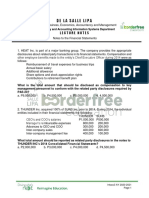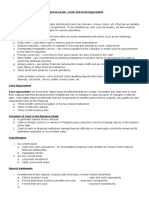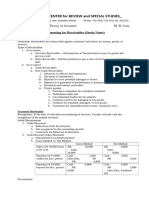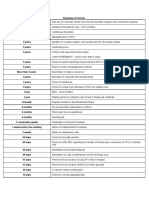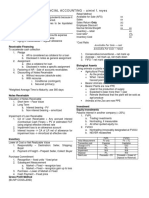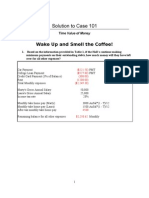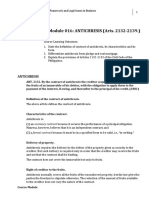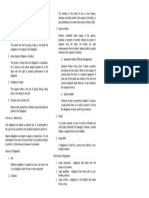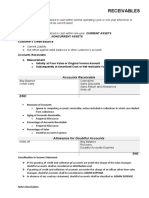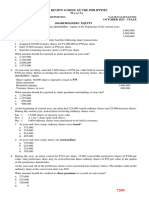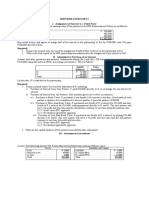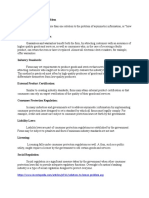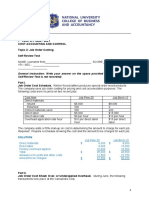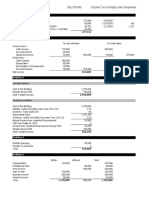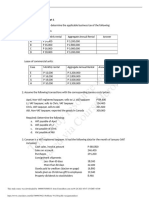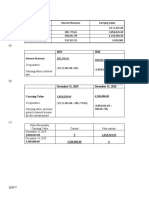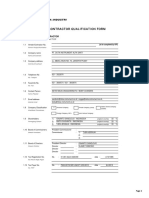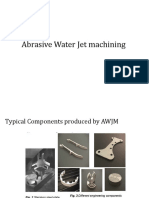1
RECEIVABLE FINANCING (DISCOUNTING)
Introduction This topic focuses more on how to compute the discounting of notes. This is similar to your
discounting of own notes in your Fundamentals of Accounting. The difference is that the note
discounted Is from another entity and that a loss is most likely computed and recorded.
Rationale Notes may be discounted at a bank to convert them into cash in case an entity needs it.
However, there may be a gain or, more likely, a loss to be incurred since banks normally
deduct interests in advance and their interest rates may be higher than that of the note
discounted.
Concept
Map Discounting
Without With
Recourse Recourse
Conditional
Sale
Secured
Borrowing
Discounting Consider the illustration below:
Assume an entity has a note receivable which was received on note date. The note will be
settled on maturity date. The entity, however, needs some cash at the discounting date,
therefore, it plans to discount the note to a bank.
The time period in [1] illustrates the portion of the note tenor, interest is already earned by
the entity. The time period in [2] is the discount period which will be the bank’s basis for its
interest income.
The entity will compute for its interest using the interest rate and principal of the note,
whereas, the bank will use its discount rate and the note’s maturity value.
The maturity value is the amount which the entity should have collected if the note has not
been discounted and was held up to maturity.
Rolling forward from the principal the entity will compare the note’s carrying amount [4] and
the rolled back amount of proceeds [5]. Any difference is the gain or loss on discounting.
� 2
Steps Step 1 Step 2
Compute the maturity value of the note. Compute the discount.
Principal xx Maturity Value xx
*If simple interest, Add: Total Interests* xx Multiply: Discount Rate xx
use I=PRT. If
compounded use Maturity Value xx Multiply:Discount Period xx
FV factors. Use Discount xx
the interest rate of
the note and total Step 3 Step 4
tenor. Compute the proceeds from discounting. Compute the carrying amount of the note.
**This is based on
Maturity Value xx Principal xx
original interest Less: Discount xx Interest Already Earned** xx
rate and time Proceeds from Discounting xx Carrying Amount xx
already passed.
Step 5
If amount in step 3 is lesser than that in step 4, there is a loss from discounting and vice
versa.
Without If the note is discounted without recourse, the bank cannot go after the entity is the issuer of
Recourse the note would not be capable of paying the note at maturity.
The note receivable is directly derecognized upon discounting.
The journal entry would normally be:
Cash [from step 3]
Loss on discounting [from step 5]
Note Receivable [principal]
Interest Income [from step 4]
With If the arrangement is with recourse and there is only a conditional sale of the note, the note
Recourse receivable discounted is disclosed as a deduction to the total notes receivable with a
disclosure of contingent liability.
If the arrangement is with recourse and the discounting is treated as a secured borrowing,
the note receivable is not derecognized and there is an accounting liability recognized.
Loss on discounting is presented as interest expense.
The journal entries would normally be:
Conditional Sale Secured Borrowing
To record the discounting:
Cash [S3] Cash [S3]
Loss on discounting [S5] Interest Expense [S5]
NR Discounted [face] Liab for Note Discounting [face]
Interest Income [S4] Interest Income [S4]
If the note is paid by maker:
NR Discounted [face] Liab for Note Discounting [face]
*This would
Notes Receivable [face] Notes Receivable [face]
maturity value, Payment if the note is dishonored by the maker:
protests fees and Accounts Receivable* [total] Accounts Receivable* [total]
other bank
charges. This Cash [total] Cash [total]
amount is a Derecognition of liabilities if the maker dishonors the note:
receivable from the
maker. NR Discounted [face] Liab for Note Discounting [face]
Notes Receivable [face] Notes Receivable [face]










